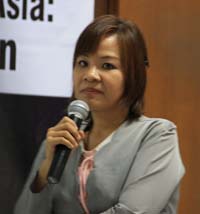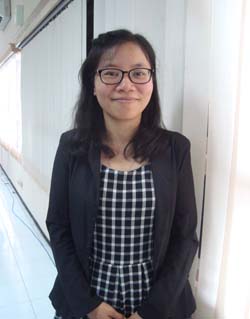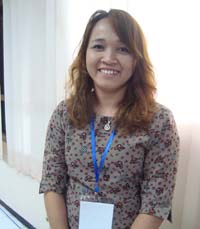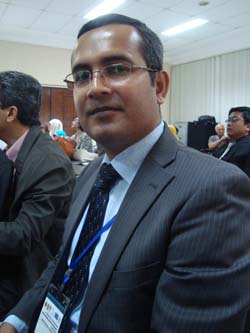Group I: Human Resources Classroom
14 May 2014
Yogyakarta - PKMK . This session begins with a brief summary of the first day of the meeting from Prof. Laksono Trisnantoro , M.Sc. , P.hD. This session reminded the participants that there are different challenges in medical care and medical curriculum that needs to be developed in the two types of communities ( rural and urban ) ASEAN. At the end of the opening session, the class is very lively with some discussion and exposure of the audience about the picture of the migration of doctors in Japan.
Oral presentation session with the theme of Human Resources presented the six papers of four papers from Thailand, Malaysia and Indonesia each one paper. The following is his review:
Session 1 : The availability of health care professionals in Indonesia, its migration and the right to health
Presenter: Ahmad Fuady , Department of Community Medicine , Medical Faculty of Indonesia University
 Ahmad FuadyThis session is unique to the digging of the right to health. Background of this study flicked that the right to health is not only limited to the right to be healthy. Further disclosed is no government obligation to fulfill the availability of health personnel to fulfill the right to health. In the other hand, migration is also seen enough help to fulfill the right to health. This study uses a method sytematic literature review of the 1998-2013 year, both locally and internationally . This study adopts the assessment guidelines of Hunt (2006 ) .
Ahmad FuadyThis session is unique to the digging of the right to health. Background of this study flicked that the right to health is not only limited to the right to be healthy. Further disclosed is no government obligation to fulfill the availability of health personnel to fulfill the right to health. In the other hand, migration is also seen enough help to fulfill the right to health. This study uses a method sytematic literature review of the 1998-2013 year, both locally and internationally . This study adopts the assessment guidelines of Hunt (2006 ) .
The study found the existence of inequality of health professionals, especially in rural areas. The main problem is the emptiness of primary care physicians as the leading services. The existence of health insurance as if it is less useful because this inequality. Looking to the upstrea, there are production problems doctors , especially in some pockets of the city physician. Inequality causes the migration of patients, so that migration is done with the promise of many professional incentive large enough to compensate for these conditions. The study concludes migration does not always improve the achievement of the right to the highest attainable standard of health.
Session 2 : Incentives to retain Physicians in public settings: the case of Phitsanulok province , Thailand
By : Pudtan Phanthunane, Naresuan University
 Pudtan PhanthunaneThis session identifies the type of incentive for physicians to maintain your health in general. Utilization of outpatient services and inpatient continues to increase, however, is not matched by the number of doctors who are willing to provide services in government hospitals into the background of the main points of this study. study design was cross-sectional. Respondents were physicians from teaching hospitals, private hospitals, community hospitals ( in Indonesian hospitals similar type D / C) and general hospitals .
Pudtan PhanthunaneThis session identifies the type of incentive for physicians to maintain your health in general. Utilization of outpatient services and inpatient continues to increase, however, is not matched by the number of doctors who are willing to provide services in government hospitals into the background of the main points of this study. study design was cross-sectional. Respondents were physicians from teaching hospitals, private hospitals, community hospitals ( in Indonesian hospitals similar type D / C) and general hospitals .
Interesting finding of this study is the incentives become important factors that affect the decision. Incentive factor is also very important for male respondents. The study found there is a considerable gap between the incentives of private doctors and doctors of civil servants. the opportunity for career enhancement becomes important at teaching hospital. The creation of a good atmosphere between colleagues the safety of life and social recognition is also a non - financial reasons to retain doctors in government service. Unfortunately, a civil servant not a major factor . The study concludes incentives play an important role in maintaining the doctor, but the hospital has a limited budget can get around by creating a good social conditions among co-workers.
Session 3 : Demand for specialists in community hospitals : From finding to policy change
By : Pudtan Phanthunane , Supasit Panarunothai , Naresuan University
This study is motivated by the lack of in-depth exploration of the needs of specialist physicians include surgeons, pediatricians, obstetricians and gynecologists ( OG ) , and internists. This condition becomes unbalanced look at the demand of medical services continues to increase. Demand a specialist in community hospitals (community hospital ) is calculated based on the demand of health care providers (based disease classification refers to the DRG) and the time required of the working process and working hours. The analysis will result in the total hours required specialist who then added hours worked per person per year. These results will be referred to their specialist needs smasing.
Surprising findings of this study, the calculation of demand specialists with this method showed a great need for specialists to be filled. Thailand is still experiencing a shortage of surgeons in 1761 , 1170 and 640 pediatrician. This study captures one of the problems of lack of specialists graduate each year. The study concludes that the solution while providing effective recommendations to address the high demand for specialists is to produce a family physician who is able to provide comprehensive medical care in a community hospital .
Session 4 : The Current demand of Community nurse in hospitals in Thailand
By : Jiraluck Nontarak , Pudtan Phanthunane , Supasit Panarunothai
 Jiraluck NontarakThe issue of an increase in chronic diseases, the composition of the population movement towards the elderly population and the implementation of UHC gives additional workload, especially the nurses in Thailand. The condition is the reason behind this study to identify the demand for nurses at a community hospital. Requests need health nurse adopt demand method by Segal and combine with the calculation of the percentage of unmet need of the Department of Public Health and welfare Health survey in 2010, as well as the workload index are excluded from Thailand Nursing and Midwives Council.
Jiraluck NontarakThe issue of an increase in chronic diseases, the composition of the population movement towards the elderly population and the implementation of UHC gives additional workload, especially the nurses in Thailand. The condition is the reason behind this study to identify the demand for nurses at a community hospital. Requests need health nurse adopt demand method by Segal and combine with the calculation of the percentage of unmet need of the Department of Public Health and welfare Health survey in 2010, as well as the workload index are excluded from Thailand Nursing and Midwives Council.
This study describes the findings for active nurses need supply 36 271 nurses Supply of nurses will be different depending on the percentage of direct care nurses. The higher proposrsi full-time care, the demand decreases, an opposite correlation. The study concluded there was no change despite new nurse graduates continues to increase.
Session 5 : Labor Price Index for Physician in Thailand
By : Phatthanawilai Inmai , Pudtan Phanthunane , Supasit Panarunothai
 PhattanawilaiUnlike other developed countries, such as America, Australia, New Zealand and Canada, Labour Price Index ( LPI ) has not been implemented in Thailand. There are no indicators that can monitor labor costs in the health sector in Thailand today. The reason is what lies behind this research . These studies aim at doctors in private and public sectors. Constructing LPI, the first estimate of aggregate weighted with sources from the Council of the National Economic and Social Development . Weight ratio of physicians per total wages wages in the public and private sectors and classification of hospitals into consideration in this calculation. Second , do the computation of LPI using Laspeyres per hour .
PhattanawilaiUnlike other developed countries, such as America, Australia, New Zealand and Canada, Labour Price Index ( LPI ) has not been implemented in Thailand. There are no indicators that can monitor labor costs in the health sector in Thailand today. The reason is what lies behind this research . These studies aim at doctors in private and public sectors. Constructing LPI, the first estimate of aggregate weighted with sources from the Council of the National Economic and Social Development . Weight ratio of physicians per total wages wages in the public and private sectors and classification of hospitals into consideration in this calculation. Second , do the computation of LPI using Laspeyres per hour .
The findings of this study account for nearly 4-7 % increase in compensation. Weight difference between the public and private sectors can also be explained, there is a big weight difference. Weights reflecting the share of labor costs and the relative importance of physician ownership in the sector. This study presented a tendency LPI stagnant existence in the public sector and an increase in the private sector began in 2011-2013. Thus, policy makers can use LPI to estimate labor costs for the healthcare market in the next year. LPI for other health professionals need to be considered.
Session 6 : Evaluating local effects of Emigration of medical professions in South Asia
By : Syed Emdadul Haque , Jose Siri , Atsuro Tsutsumi , Anthony Capon , United Nations University - International Institute for Global Health ( UNU - IIGH ) , Malaysia
 Syed EmdadulInequality is the condition of being in the spotlight . Inequality in health personnel is directly proportional to the chances of migration , " Brain Drain " or " Brand Gain ". Like a double-edged sword, migration can be a positive and negative impact locally . Conditions that lies behind this study. Using the methods of literature review, this study aimed to characterize trends in the migration of health workers in Asia sSlatan and contribute what is given in the development of the health system.
Syed EmdadulInequality is the condition of being in the spotlight . Inequality in health personnel is directly proportional to the chances of migration , " Brain Drain " or " Brand Gain ". Like a double-edged sword, migration can be a positive and negative impact locally . Conditions that lies behind this study. Using the methods of literature review, this study aimed to characterize trends in the migration of health workers in Asia sSlatan and contribute what is given in the development of the health system.
This study highlights three main points to explain the impact of migration in South Asia, including labor and financial losses, skill and remmitance. Migration of medical personnel created a crisis of skilled medical personnel in South Asia. The impact is seen in financial losses and have to face the health vulnerability of these conditions. On the other hand, migration is able to improve the skills of medical professionals and bring remmitance big enough for the state medical suppliers. Thus, decision makers need to better understand the costs and benefits of such emigration and their relative magnitudes.

